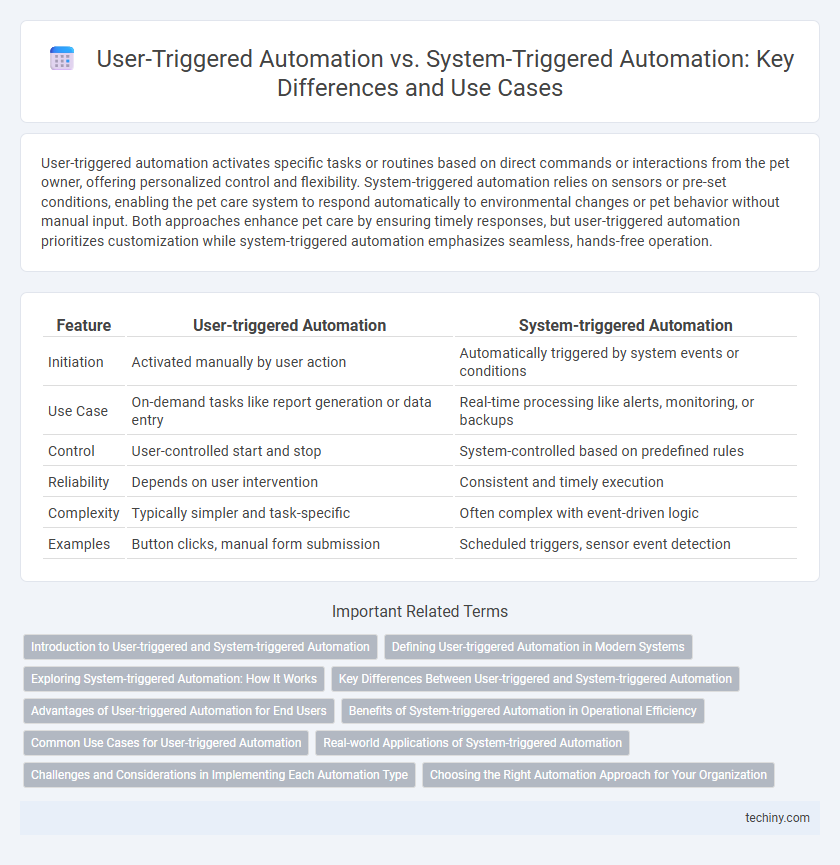User-triggered automation activates specific tasks or routines based on direct commands or interactions from the pet owner, offering personalized control and flexibility. System-triggered automation relies on sensors or pre-set conditions, enabling the pet care system to respond automatically to environmental changes or pet behavior without manual input. Both approaches enhance pet care by ensuring timely responses, but user-triggered automation prioritizes customization while system-triggered automation emphasizes seamless, hands-free operation.
Table of Comparison
| Feature | User-triggered Automation | System-triggered Automation |
|---|---|---|
| Initiation | Activated manually by user action | Automatically triggered by system events or conditions |
| Use Case | On-demand tasks like report generation or data entry | Real-time processing like alerts, monitoring, or backups |
| Control | User-controlled start and stop | System-controlled based on predefined rules |
| Reliability | Depends on user intervention | Consistent and timely execution |
| Complexity | Typically simpler and task-specific | Often complex with event-driven logic |
| Examples | Button clicks, manual form submission | Scheduled triggers, sensor event detection |
Introduction to User-triggered and System-triggered Automation
User-triggered automation activates processes in response to specific actions performed by users, such as clicking a button or submitting a form, enabling personalized and interactive workflows. System-triggered automation operates independently, initiating tasks based on predefined criteria or events like time schedules, sensor inputs, or system status changes, ensuring consistent and timely execution of routine processes. Both automation types enhance operational efficiency by aligning task initiation with either user intent or system intelligence.
Defining User-triggered Automation in Modern Systems
User-triggered automation in modern systems refers to processes initiated directly by user actions, such as clicks, commands, or inputs, enabling personalized and on-demand execution of tasks. This type of automation enhances user control, responsiveness, and efficiency by allowing users to activate features only when needed, reducing unnecessary system operations. Key examples include workflow initiations in software applications and interactive bots responding to specific user queries or commands.
Exploring System-triggered Automation: How It Works
System-triggered automation operates through pre-defined conditions or events within software or hardware infrastructure, activating processes without human intervention. This method relies on real-time data inputs, sensors, or system status changes to initiate automated tasks, enhancing operational efficiency and accuracy. Common applications include network monitoring, anomaly detection, and automatic software updates that occur seamlessly based on system performance or detected triggers.
Key Differences Between User-triggered and System-triggered Automation
User-triggered automation requires manual initiation by users, often through clicks or specific commands, enabling control and customization in real-time operations. In contrast, system-triggered automation operates automatically based on predefined rules or events, such as time schedules or data changes, ensuring consistent and timely task execution without user intervention. Key differences include initiation method, control level, and response speed, with user-triggered automation favoring flexibility and system-triggered automation prioritizing efficiency and reliability.
Advantages of User-triggered Automation for End Users
User-triggered automation empowers end users with greater control and customization, allowing them to initiate processes precisely when needed, enhancing flexibility and responsiveness. This approach reduces the risk of unwanted system actions, improving user confidence and satisfaction. It also facilitates personalized workflows, enabling users to tailor automation to their specific tasks and preferences.
Benefits of System-triggered Automation in Operational Efficiency
System-triggered automation enhances operational efficiency by enabling real-time responses to specific events without manual intervention, reducing delays and errors. This automation type optimizes workflows by automatically initiating processes based on predefined conditions, ensuring consistency and scalability across business operations. Integrating system-triggered automation minimizes human resource dependency, allowing teams to focus on strategic tasks and improving overall productivity.
Common Use Cases for User-triggered Automation
User-triggered automation is commonly used in workflows requiring direct human input, such as approving expense reports, initiating customer support tickets, and updating CRM records. These automations enhance efficiency by minimizing manual repetitive tasks while ensuring user control and decision-making at critical points. Examples include triggering marketing email campaigns based on user clicks or starting document review processes following user submission.
Real-world Applications of System-triggered Automation
System-triggered automation powers critical real-world applications such as automated fraud detection in banking, where algorithms analyze transaction patterns and instantly flag suspicious activity without human intervention. Industrial manufacturing leverages system-triggered automation for predictive maintenance by monitoring equipment conditions and scheduling repairs before failures occur, reducing downtime and costs. Smart home systems also employ this automation type by automatically adjusting lighting, heating, and security based on environmental sensors and user behavior patterns, enhancing convenience and energy efficiency.
Challenges and Considerations in Implementing Each Automation Type
User-triggered automation demands precise timing and user engagement, posing challenges in ensuring consistent activation and preventing workflow disruption. System-triggered automation requires robust integration and real-time data processing to respond appropriately to events, with considerations around false positives and system resource allocation. Both types necessitate thorough testing and monitoring to balance efficiency gains against potential errors and user experience impacts.
Choosing the Right Automation Approach for Your Organization
User-triggered automation relies on manual inputs to initiate processes, offering greater control and customization for tasks requiring human judgment, while system-triggered automation activates workflows based on predefined conditions or events, enhancing efficiency and consistency through real-time responsiveness. Selecting the right automation approach involves analyzing organizational needs such as the complexity of tasks, frequency of execution, and the importance of user intervention in workflows. Balancing user-triggered and system-triggered automation can optimize operational performance by combining precision control with scalable, automated efficiency.
User-triggered Automation vs System-triggered Automation Infographic

 techiny.com
techiny.com